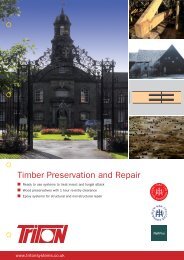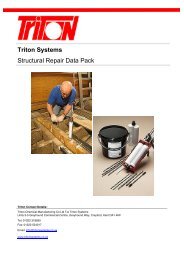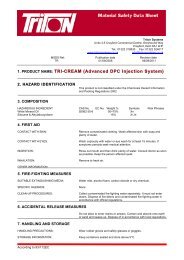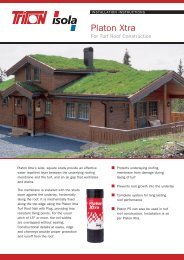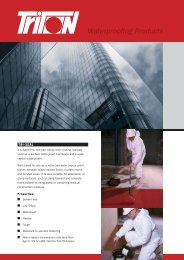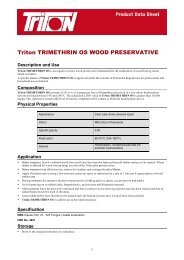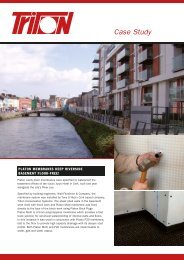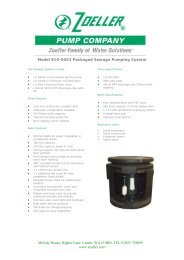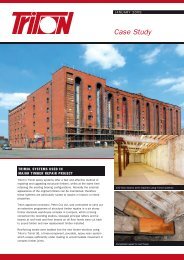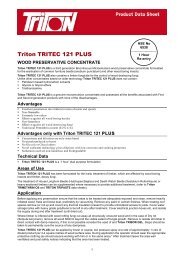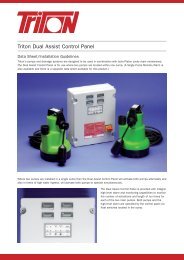Tri-Cream Data Sheet Download - Triton Chemicals
Tri-Cream Data Sheet Download - Triton Chemicals
Tri-Cream Data Sheet Download - Triton Chemicals
Create successful ePaper yourself
Turn your PDF publications into a flip-book with our unique Google optimized e-Paper software.
<strong>Tri</strong>ton TRI-CREAM<br />
ADVANCED D.P.C INJECTION SYSTEM<br />
• Fast, clean installation<br />
• No high-pressure pump required<br />
• Virtually odourless, low hazard<br />
• Precise dosing<br />
• No pump cleaning required between jobs<br />
Description<br />
<strong>Tri</strong>ton TRI-CREAM is a unique blend of silane & siloxanes for injection into brickwork etc., for the control of rising<br />
dampness. <strong>Tri</strong>ton TRI-CREAM can be used in all types of masonry without the use of high-pressure equipment. The<br />
cream is delivered by hand pressure only from a simple displacement pump and injector lance into a series of holes<br />
drilled into the mortar course. From here it migrates rapidly into the masonry pores where the injection cream reverts to<br />
a liquid phase and polysiloxanes are formed in situ. During the curing period a low molecular-weight silane vapour is<br />
also produced giving excellent migration through the wall. Curing of the DPC starts immediately with the final cure<br />
taking 2-6 weeks depending on wall thickness. Extensive field experience with this technology demonstrates that<br />
<strong>Tri</strong>ton TRI-CREAM will perform as well as any conventional liquid injection system against rising damp.<br />
Installation<br />
In all cases the damp proof course should, as far as possible, be installed in accordance with the British Standard<br />
‘Code of Practice for Installation of Chemical Damp Proof Courses’ BS6576 (1985). In particular, the inserted DPC<br />
should be below the level of timber floors unless prevented by structural considerations (in which case other measures<br />
may be required to isolate joists etc. from damp walls below the DPC). <strong>Tri</strong>ton TRI-CREAM is designed to control rising<br />
damp but walls can remain damp after DPC installation where they are severely contaminated with hygroscopic salts.<br />
Special measures may be required to provide long-term control of dampness in such walls.<br />
Preparation<br />
Check and overhaul rainwater goods to ensure they are in good order and clean, repair or install drains to carry away<br />
surface water. If internal floors are below external ground level form trenches along the external face of the walls to at<br />
least 150mm below the proposed DPC level (where foundation depth allows). If this approach is not feasible the DPC<br />
must be placed 150mm above external ground level and the internal walls tanked below the DPC to prevent lateral<br />
migration of moisture/salts.<br />
Remove skirtings, fixings and render/plaster to expose the line of the proposed DPC (mortar bed). Internal plaster which<br />
may be contaminated with hygroscopic salts should be ‘cut-back’ a minimum of 1m above the DPC line or 300mm above<br />
the highest signs of dampness/salts. Check flooring timbers for signs of fungal decay and recommend<br />
repair/replacement as appropriate. Ensure wall cavities are cleared of debris.<br />
Drilling and Injection<br />
Walls vary in thickness and type of construction so it is essential these factors are taken into account before deciding on<br />
an appropriate drilling pattern. Older properties may consist of several different styles of construction and the<br />
specification of drilling and injection should be varied accordingly. DPC height should always be at least 150mm above<br />
external ground level. In the case of solid floors, insert the DPC as close to floor level as possible. Vertical DPCs should<br />
be provided to connect horizontal DPCs where ground levels change and to isolate untreated wall areas (adjoining<br />
properties, garden walls, etc). In most cases solid brick walls may be drilled/injected from one side only (in accordance<br />
with the guidelines in the Table overleaf).<br />
For cavity walls each leaf may be dealt with as a separate 115mm thick wall (see below). Alternatively, if preferred, drill<br />
through the selected mortar course, across the cavity, then drill the other leaf of brickwork to a depth of 90-100mm and<br />
inject in one continuous process (the physical properties of <strong>Tri</strong>ton TRI-CREAM ensure the cream remains in contact with<br />
the surrounding mortar even when the mortar bed is drilled through in this way). Always ensure that the cavity is clear<br />
before treatment.<br />
1
In random stone and rubble infill walls, as far as practically possible, follow the mortar course at the appropriate level.<br />
However, if the stone is of a porous type, it may be possible to vary the drilling location (mortar/stone) as long as the<br />
mortar bed perpends are treated.<br />
In walls of greater than 350mm thickness it is recommended that drilling is undertaken from both sides at a<br />
corresponding height. In the case of drill holes becoming blocked these should be re-drilled just prior to injection or a<br />
new hole drilled nearby to ensure that an adequate volume of <strong>Tri</strong>ton TRI-CREAM is introduced.<br />
Drill hole size, Depth and Location<br />
Drill 12mm diameter holes horizontally in the mortar bed at centres no greater that 120mm. The depth of hole required<br />
for various sizes of wall is shown in the table below. For walls of intermediate thickness the depth of holes should be pro<br />
rata. Where the masonry is irregular, ensure the horizontal drilling pattern targets the base of all perpends of the course<br />
selected.<br />
Drill hole depth required for walls of various thickness:<br />
Wall Thickness 115mm 230mm 345mm 460mm<br />
(4.5”) (9”) (13.5”) (18”)<br />
Depth of hole 100mm 100mm 220mm 330mm 410mm<br />
<strong>Tri</strong>-<strong>Cream</strong> Injection<br />
Fill the applicator unit with the <strong>Tri</strong>-<strong>Cream</strong> (approx. fill capacity 5.0ltr) and use the hand-pump to establish a positive<br />
pressure of approx. 1 bar (15lb/in²). Insert the lance of the <strong>Tri</strong>ton TRI-CREAM application gun into the full depth of the<br />
pre-drilled hole. Squeeze the gun trigger and back fill each hole fully with <strong>Tri</strong>ton TRI-CREAM to within 1cm of the<br />
surface. When treating cavity walls from one side make certain that the holes in each leaf are filled.<br />
Application Rates*<br />
Wall Thickness 115mm 230mm 345mm 460mm<br />
<strong>Tri</strong>-<strong>Cream</strong> per 10m 0.9ltr 1.9ltr 2.9ltr 3.9ltr<br />
*certain types of construction may result in higher retentions, e.g., up to twice the above figures in rubble filled walls.<br />
Some allowance should also be made for wastage (ca. 10%).<br />
Finishing Works:<br />
On external faces of walls drill holes can be re-pointed using a matched mortar or plugged with plastic caps of a suitable<br />
size and colour. On internal faces holes can be left open and plaster stopped short of the DPC.<br />
Replastering:<br />
The removal and replacement of internal salt contaminated plaster is an important part of effective damp proofing works<br />
(salts left by rising damp are hygroscopic and can cause future staining independently of structural dampness). It is<br />
essential, therefore, to follow specific guidelines drawn-up for dealing with the particular challenges posed by damp/saltaffected<br />
surfaces.<br />
It is advisable to leave walls injected with <strong>Tri</strong>ton TRI-CREAM to dry for as long as possible, and for at least 14 days,<br />
before removing excess salts and commencing re-plastering.<br />
Packaging<br />
<strong>Tri</strong>ton TRI-CREAM is packed in a 5 litre Tub<br />
2
Storage<br />
Store in cool, frost-free conditions (temporary exposure to slight frost in transit should not affect usage and stability).<br />
Precautions<br />
See separate Health & Safety sheet.<br />
For further information please contact:<br />
<strong>Tri</strong>ton Chemical Manufacturing Co Ltd T/a <strong>Tri</strong>ton Systems<br />
Units 3 – 5 Crayford Commercial Centre, Greyhound Way, Crayford, Kent DA1 4HF<br />
Tel: 01322 318830 Fax: 01322 524017 Email: info@tritonsystems.co.uk<br />
www.tritonsystems.co.uk<br />
Ref: <strong>Tri</strong>ton <strong>Tri</strong>-<strong>Cream</strong> 07/11<br />
Ref: <strong>Tri</strong>ton Swellseal Mastic 11/10<br />
3



